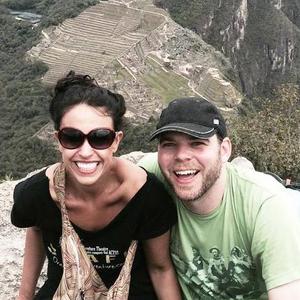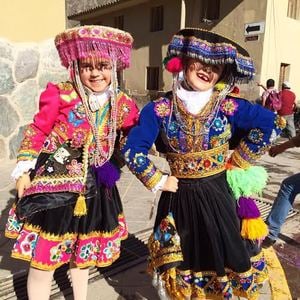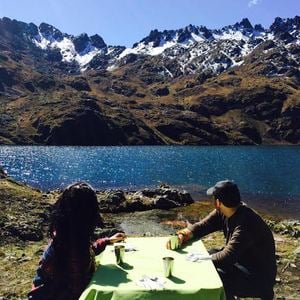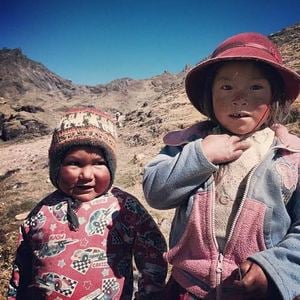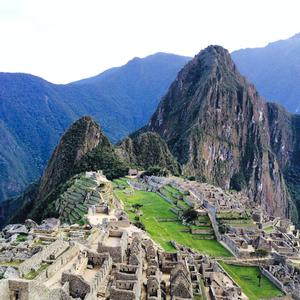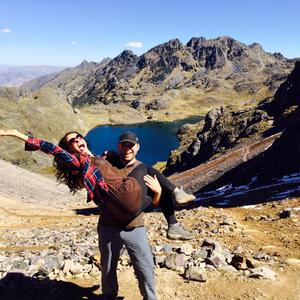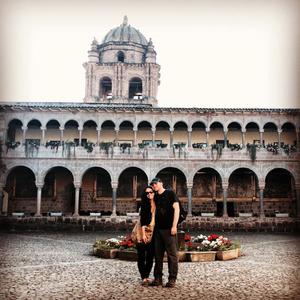Christen & Jason
“I love how the constellations are upside-down here,” I say to my new husband on one of our first nights honeymooning under the Peruvian stars. At 15,000 feet above sea level, they feel closer too, I think. “Maybe this is right-side-up,” Jason says, his voice somewhat muted by a dark green, hand-made alpaca scarf pulled tightly around his face.
“Your honeymoon destination is cold?” someone asked in shock as we prepared for our trip. In place of sunscreen and swimsuits, we filled our new backpacks with waffle-print thermals; carb-packed Cliff bars; and the thickest socks we could find. (We even included some of this gear on our Traveler’s Joy registry page!) “Yup, it’ll be cold,” we’d say. And was it ever, especially on the nights we slept in our own private outdoor mountain tent for two.
Sure, the Andes Mountains are cold, but other words we’d use to describe them are massive, still, quiet, sacred, colorful, and, of course, romantic—even though we couldn’t shower for four out of our seven days there. We didn’t care. With our private guide, local chef, and three donkeys who held our camping and cooking supplies, we hiked for days straight as close to the open sky as we’d ever come; we reveled in the calm stillness that came with no commercial frills: no running water, no phones, no electricity, no heat, and no seating charts; we were finally free of wedding planning!
Our choice to spend our June, 2014 honeymoon here—in the Andes—came pretty easily. See, six years earlier, we’d fallen in love there.
When I’d set out for the Ecuadorian Andes in 2009—invited to teach English and Theater workshops in a small Quechuan village called Quilotoa by an international theater organization called Dramatic Adventure Theatre—I had no idea that I would meet my future husband on the trip. I think he was pretty surprised, too.
One of my main jobs in the small indigenous community where I lived that frigid Andean summer was to train and lead teams of American teaching artists who cycled in and out every week during our two-month service arts project. Jason was leading one of those groups of artists when I got to know him. He was a playwright from North Carolina, living in Brooklyn. In truth, I didn’t even really notice him until I read some of his writing and watched him work with our students. He was brilliant, I soon saw, which was—admittedly—distracting. During the eight days he was there with me, I didn’t even notice the cold; those teenage-era butterflies flapping around inside my almost-thirty-year-old belly kept me warm, I guess.
As we fell in love that summer, we learned quite a bit about a native Andean folktale sometimes called “The Condor and the Girl,” which is depicted in almost every traditional painting in the area. Well-known within the Quechua speaking communities of the Ecuadorian and Peruvian Andes, the tale features an indigenous Quechua shepherd girl who falls in love with a condor disguised as a boy. A rare vulture with a wingspan that can reach up to almost twelve feet across, the condor is considered the most sacred animal within the Quechua community, a bird that flies the distance between humans and Gods: a messenger. Seeing one is considered an important “sign,” and so we knew why everyone was so excited the morning one was spotted flying over Quilotoa’s turquoise crater-lake.
Busy prepping a lesson for the day, I’d missed it, and so had Jason; he’d been writing near the lake and hadn’t looked up in time to notice his silent company. We watched together for the rest of that week, and I kept watching and waiting for one to return the whole rest of that summer, but it never happened. I hoped that our both missing our chance wasn’t, in itself, a “sign.”
Soon after we got back to New York, Jason and I became an official couple. Though we’d left the Andes and were making a life together in the city, the rural Andes never left us; we went to South American restaurants, listened to Quechuan music at home, and even went back again the following summer. We took on permanent roles with the theater company that brought us together, and worked for years together on a play inspired by the mountains of our dreams and the bird we never saw.
The play, entitled A Girl without Wings written by Jason and dramaturged by yours truly, presented a new spin on the Condor love story with both indie twists and contemporary puppetry. Co-produced by Dramatic Adventure, it went up at IATI Theater on NYC’s Lower East Side. New York loved learning about the mystical, endangered condor as much as we had, and throughout the run we often fielded questions about the myth, its meanings, its variations, and Jason’s script. Disappointedly, we always told the truth when asked if we’d ever seen one.
Throughout our first few years together, we didn’t talk much about getting married until one day when we half-seriously joked about hosting an Andean ceremony up in Quilotoa for all of our American friends and family. “We could get a shaman to do the ceremony at the lake!” I’d said, “…and imagine if a condor came!” Faced with the realities that: 1. a condor probably wouldn’t RSVP, 2. the trip would be expensive for our guests, and 3. our grandparents probably wouldn’t do so well in such high altitude, we soon substituted the South American Andes for New York State’s Catskills and planned the ceremony of our dreams here at home. It even started out with a tribute to Pacha Mama, the Incan Mother Goddess, who’s said to watch over the Andes and the Quechuan people. We’d save the travel for the honeymoon.
Two days after the ceremony, we finally left for Peru; we couldn’t have been more excited! In a way, it felt like our union wouldn’t be totally complete until we arrived. Though we’d never been to the Peruvian side of the mountain range, that which Traveler’s Joy allowed us to explore for the very first time, when we arrived, we felt that we were finally home, finally married; it was here that we began and here that we would begin again.
Since I’d been so focused on the wedding itself, Jason took over planning the entire honeymoon for us. On our first night, instead of heading straight to Cuzco (which would make sense given our need to acclimate to the altitude there before heading to Machu Picchu) he, instead, had us head miles out of our way just to spend one evening in Lima’s Mira Flores. The neighborhood is reportedly home to the world’s best ceviche, and we were headed there because the dish is my favorite South American food. We talked about the meal several times on the plane and about how crazy it was that we’d stay one night in Lima—where we’d rush to a far-out neighborhood close to an hour from where our early morning flight to Cuzco would take off—just for two bowls of raw, lime-soaked fish. It was one of the first gifts we requested on our Traveler’s Joy registry and one of the first purchased by guests. We couldn’t wait!
Turns out, however, that we’d have to; our plane was delayed, and we wouldn’t end up at our bed and breakfast until close to 10 pm. We would also learn that ceviche is a classic lunch dish in Peru (who knew?) and wasn’t usually a dinner “thing.” Not only was it too late for ceviche, but it also seemed that we were, in fact, too late for almost every other dinner option too. Each restaurant within walking distance would be closed by the time our honeymoon officially started on night numero uno.
The only thing available—our kind and apologetic innkeeper told us—was Kentucky Fried Chicken. And so, on that first night, we sat together on a Lima patio facing a dark and empty street corner, holding hands, and eating American fast food delivery. Sure, it wasn’t ideal, but it was pretty funny. And, in truth—as I’ve told the couple who gifted us this ceviche meal through Traveler’s Joy—after weeks of rigorous dieting for my wedding photos, greasy KFC was actually one of my favorite meals of the trip!
Luckily, our ceviche dinner was the only Traveler’s Joy registry gift we didn’t get to enjoy. Everything else worked out perfectly according to plan and even better at times. In Cuzco, we visited museums, sampled chifa (a well known Peruvian-Chinese food), and walked endless street markets littered with fluttering chickens, baked goods, cilantro, and bright red rambutan, a “hairy” fruit that curiously resembles a tiny Muppet. We also visited several nearby Incan ruins on horseback, a wedding gift from our generous friends and family who understand our love of travel, South America, and each other.
After a few nights relaxing in an eco-friendly hotel and eating in some of historic Cuzco’s fancier restaurants, we departed for what the locals call “the Lares Trek.” This hike, which we chose to do via private tour, is a lesser-known alternative to the Inca Trail that wound us through mountain villages on quiet, deserted paths before its completion in the bustling Aguas Calientes, the famous “last stop” town before arriving in Machu Picchu.
Our trek, led by local guide (and fast friend) Orlando, started us out at the mud-bath type Lares hot springs where we soaked and prepared for the trek ahead. Our warm swim was followed by our first home-cooked picnic by Pablo, an older indigenous man with deep lines that webbed across his wind-burnt cheeks. He spoke mostly Quechua and would prepare incredible traditional food for us from scratch over a fire for each meal throughout the next several days. While I knew there were several picnics planned, those which were also gifted to us by our wedding guests, I had no idea that our guide and chef would have a small table and chairs ready for us at each meal or that the whole tableau would be accessorized with a pressed table cloth and real silverware. For lunch and breakfast, our guide and chef carefully selected our meal locations; we ate at sun-soaked caldera lakes and, at night, we’d eat by candlelight in empty lean-tos, where we took refuge from the cutting wind.
On the first night of our hike, we told Orlando about our previous time in the Andes together and about our fascination with the Andean condor. “You know that seeing this bird is very rare, yes?” he asked, a sort of disclaimer. We knew, we told him. “They’re endangered; we probably won’t see one,” he warned. We told him we understood, but he said he’d keep an eye out. “If we do though,” he added after a few quiet moments, “this is a good thing.” We all nodded.
After a second full day of (mostly uphill!) hiking, we reached Pablo’s village, where he made us dinner in his own small one-room home. He invited us in and prepared another three-course meal for us including classic dishes such as quinoa soup topped with fire-popped corn. We all ate together that night, accompanied even by Pablo’s 27 guinea pigs or cuy (pronounced coo-ee in Quechua—a delicacy in the indigenous community), who crisscrossed our feet under the table. As we struggled to chat over the rodents’ calls, we soon learned how they got their name; their gleeful squeals echoing through the concrete home in an overlapping chorus made it clear. “Cooo—Eeeee!” they announced themselves over and over in tiny voices.
When we woke up and peeked outside our tent the following morning, we found that several of Pablo’s neighbors had come to meet us; they wore colorful hats and were accompanied by soft llamas with long lashes. We bought textiles and scarves from them before heading out for our next day of hiking, where, along the way, we met more locals, with whom we shared salutations and candy. Some of the children we met first appeared as small dots on the horizon as they ran to meet us, eventually catching up; panting and out of breath they’d seen us from far away and had ran to greet us and to see what candy we carried.
On our last day of the hike, we talked about our impending Machu Picchu visit the next morning. Orlando explained that the site is considered a deeply sacred space for the Quechuan community, and we asked questions about its history and meaning. As we chatted, stopping to take pictures of the breathtaking last views of our lonely mountain trek—some of our last before we would face the crowds at Machu Picchu in the morning—Orlando suddenly stopped talking and fell still. We held our breath as he looked up and pointed his walking stick toward the sky. “There,” he said, barely audible. “The condor.” Our eyes flew to the clouds just in time to see the giant bird disappear behind the mountain peak to which it was headed. Seemingly miles above us, we couldn’t quite grasp its full size, but we all knew what we saw; we all saw its colossal shadow cover our path. “Wow,” Orlando whispered. “You, my friends, are lucky. This is good.”
The next day, our last, we spent close to six hours at Machu Picchu, that which was designed in the shape of a condor, trying—quite unsuccessfully—to pin down its beauty and spirit in our flat iPhone photos. We didn’t even come close, but we love looking at the attempts in our photo albums from that day and from the whole trip. And while we never had the opportunity to even try and grab a photo of that condor, it didn’t matter. We knew we were lucky enough to have a second chance at the rare sighting, that the condor had blessed our trip, our union, our love. And we knew too that we were lucky to even be there again, to have each other, our art, our travels, and the support of our friends and family. They are our true good omens, we knew; they’d watched us grow, given blessings, offered advice, supported our decisions, and encouraged our love.
That so many of our guests chose to gift us experiences from our Traveler’s Joy registry evidences just how much they know, love, and understand us. Needless to say, when it comes to the registry, we wholeheartedly support Traveler’s Joy’s suggestion to “skip the blender.” We’re sure glad we did.


